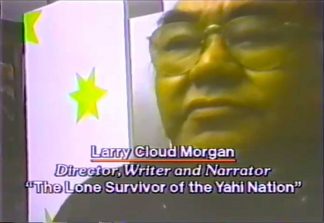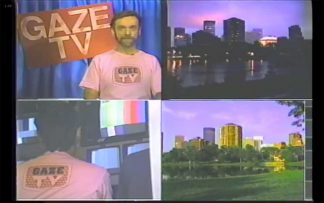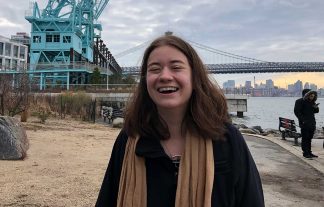By Allison Campbell-Jensen
“The pandemic has been a horror,” says Rachel Mattson, Curator of the Jean-Nickolaus Tretter Collection in Gay, Lesbian, Bisexual and Transgender Studies. One of the projects that has kept the Tretter staff connected, supported, engaged — and able to support a wide range of research inquiries — throughout the pandemic is a project organized around a Twin Cities public access television show, GAZE-TV.
GAZE-TV ran from 1986 until Pride season 1992, and then as Green And Yellow (GAY) TV until Pride season 1995, on a dozen Twin Cities Metro area cable TV Public Access channels. The program was hosted by Brad Theissen, who had a B.A. in Journalism (1972), and 10 prior years of experience in the production of live television, newspaper reporting and production, and radio news writing and reporting.
From 1981 to 1991, he was the head DJ at The Gay 90s nightclub, and used that platform to launch and host the GAZE-TV/Green And Yellow TV show for the Twin Cities GLBT community, in cooperation with his GAZE Magazine/Twin Cities GAZE Newspaper 1985-1992, GAZE BBS Computer Bulletin System 1986-1992, and Unicorn Theatre 1988-1992. (There was also a short return of GLBT-TV running from Pride 2003 to Pride 2004, when Brad relocated to Hollywood, Los Angeles, California.)
The 238 videos that Theissen donated to the Tretter Collection had been digitized and made available on UMedia before Mattson came to the University Libraries in 2018. But items in the collection were described in only very rudimentary ways — which made it hard for researchers to find content of interest. Improving access to them was on her to-do list for a long time; it rose to the top when staff shifted to working remotely. Students, part-time employees, and interns were assigned to view GAZE-TV and write descriptions of episode contents to facilitate researchers’ ability to find materials on specific topics.
Information, please
One of those student workers is Sofia Nwanokwale, a senior majoring in Studies in Cinema and Media and English. The 22-year-old, who grew up in the era of the internet and social media, was interested to discover that this TV show, along with word of mouth and newspapers, was an important resource for the LGBT community to hear about events.
“Truly the amount of things you could learn from these broadcasts was really awesome,” she says. Along with local events and news of the time, she’s learned about popular culture and music of the 1990s.
The GAZE-TV collection is rich, says Archives Assistant Eliza Edwards; “for a lot of people, it was a lifeline of information.” It began as an AIDS prevention and education show but included other topics. “There’s this whole range of things that goes from the more serious — AIDS, police brutality, political organizing, and public policy, things that are relevant to LGBT people — also this side of artistic production, music, and theater,” Edwards says.
The value of GAZE-TV
That wide scope of the show makes it valuable. Edwards has recommended GAZE-TV to a variety of researchers, “from people looking into conversion therapy, to people researching AIDS caretakers, to people looking into the entertainment industry, and the history of art production in the Twin Cities.” There is footage from protests and from Pride parades, interviews with politicians and with Two-Spirit people from Native American communities, and conversations about topics relevant today and about history not available elsewhere.
During the pandemic, Edwards has been grateful to be able to point researchers to a resource they can access from home.
“It’s accessible to a whole range of people who, five or six years ago, would literally have had to come into the archives and take a VHS and pop it into the TV,” she says.
Impactful viewing
“As a young bisexual woman, the AIDS crisis is something I didn’t live through, so watching these episodes has been an invaluable window into understanding what those who came before me experienced at that time.”
—Eliza Edwards
Edwards has been emotionally moved while viewing GAZE-TV.
“As a young bisexual woman, the AIDS crisis is something I didn’t live through,” she says. “So watching these episodes has been an invaluable window into understanding what those who came before me experienced at that time.”
She finds resonance with dealing with COVID today, as well as historical memory that lives in her body as a queer person.
The first episode she watched was a tribute to Dick Hanson, an HIV-positive political organizer for the farm movement, the DFL party, and LGBT issues. A bit like a funeral but held while he and his partner Bert Henningson were both still living, the tribute featured speeches, shared memories, and performances by dancers and musicians.
As Edwards watched the shows, which are not necessarily in chronological order, she noticed that Theissen interviewed many political and artistic figures who were HIV-positive. “Especially for the people who made repeat appearances, I realized after several months of working on the project that I was actually watching them die on screen,” she says. “After jumping around in a nonlinear fashion, I eventually would come across footage of a memorial.”
When the NAMES Project AIDS Memorial Quilt came to Carleton College in Northfield, GAZE-TV was there, recording footage that Edwards found “compelling and really heart-breaking.” The camera person walks among the quilt sections and the tearful reactions of people can be heard. Then the focus turns to a commemoration made of well-worn jeans. “To see something from someone’s life as intimate as their jeans, that already had an impact,” Edwards says. “Then the camera zooms in and you realize these are the quilt squares for Dick Hanson” and his partner.
“To see the absolute loving care someone took to stitch together their jeans and to rest them together that way — it was just incredible,” she says.
Grace notes

Larry Cloud Morgan, an Ojibwe activist and artist, preparing a theatrical production called “The Story of Ishi.” Ishi was the lone survivor of the Yahi Nation, who lived the last five years of his life being studied in a museum.
While viewing an episode from the 1990s, Nwanokwale was pleasantly surprised to encounter a segment on religion.
“Of course, there’s space to be religious and be queer. That’s a common thing these days,” she says. “I was just surprised to see Christianity and the LGBT community talked about it in such close proximity in the early ’90s.” The message to accept yourself and accept faith in your life seemed forward-thinking to her.
Another compelling experience came with a video about Larry Cloud Morgan, an Ojibwe activist and artist, preparing a theatrical production called “The Story of Ishi.” Ishi was the lone survivor of the Yahi Nation, who lived the last five years of his life being studied in a museum. The rehearsals of Morgan and other indigenous activists, Edwards says, were not the usual reading of lines. “A lot of their rehearsals were healing processes, talking about the impact of colonialism on indigenous communities.”
Edwards also has found joy in GAZE-TV. Among her favorites is a series of videos from the 1990 Pride festival featuring the late singer Debbie Duncan. Her performances were also ASL interpreted. “The camera is moving between Debbie Duncan, who has her own incredible language of movement, and the ASL interpreter, who is just going ham, signing beside her,” Edwards says with a laugh.
The people whom Edwards has encountered in paper documents in the Tretter Collection come to life in a new way through GAZE-TV. Now they and many others are within reach for a much larger audience. “After a lot of work from many, many people,” Edwards says, “the end is in sight for this project, which is very exciting.”







I wanted to thank all of you that helped catalog the GAZE-TV episodes. I found the tapes compelling when I was involved with transcoding the original analog tapes at MediaPreservation in Pa. In a way the saying ” it takes a village” is really true ,from Brad and Mr Kitty to the history he preserved in outreach ,the effort and effect transcends generations .
As an extremely involved volunteer during the time of Gaze TV in the 90’s, I appreciate the work you are investing in this project. The events of that era are close to my heart which, now 70, still fuels my lifeblood. If there is anything I can ever do to assist you please don’t hesitate to call.
Elizabeth Andres